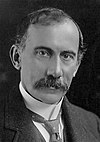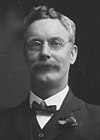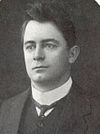First Hughes ministry | |
|---|---|
11th Ministry of Australia | |
 Photo of the First Hughes ministry | |
| Date formed | 27 October 1915 |
| Date dissolved | 14 November 1916 |
| People and organisations | |
| Monarch | George V |
| Governor-General | Sir Ronald Munro Ferguson |
| Prime Minister | Billy Hughes |
| No. of ministers | 10 |
| Member party | Labor |
| Status in legislature | Majority government |
| Opposition party | Liberal |
| Opposition leader | Joseph Cook |
| History | |
| Legislature term | 6th |
| Predecessor | Third Fisher ministry |
| Successor | Second Hughes ministry |
| ||
|---|---|---|
Term of government (1915–1923)
Ministries Elections |
||
The First Hughes ministry (Labor) was the 11th ministry of the Government of Australia. It was led by the country's 7th Prime Minister, Billy Hughes. The First Hughes ministry succeeded the Third Fisher ministry, which dissolved on 27 October 1915 following Andrew Fisher's retirement from Parliament to become the next High Commissioner to the United Kingdom. The ministry was replaced by the Second Hughes ministry on 14 November 1916 following the split that took place within Labor over the issue of conscription. This led to Hughes and his supporters leaving the party to form the National Labor Party.[1]
King O'Malley, who died in 1953, was the last surviving member of the First Hughes ministry; O'Malley was also the last surviving member of the Second Fisher ministry.
Ministry
[edit]| Party | Minister | Portrait | Portfolio | |
|---|---|---|---|---|
| Labor | (Rt) Hon Billy Hughes KC (1862–1952) MP for West Sydney |

|
| |
| Hon William Higgs KC (1862–1951) MP for Capricornia |

|
| ||
| Hon King O'Malley (1858–1953) |

|
|||
| Hon Hugh Mahon (1857–1931) MP for Kalgoorlie |

|
|||
| Hon Frank Tudor (1866–1922) |

|
| ||
| Hon George Pearce (1870–1952) Senator for Western Australia |

|
|||
| Hon Jens Jensen (1865–1936) |

|
|||
| Hon William Webster (1860–1936) |

|
|||
| Hon Albert Gardiner (1867–1952) Senator for New South Wales |

|
| ||
| Hon Edward Russell (1878–1925) |

|
| ||
References
[edit]- ^ "Ministries and Cabinets". Parliamentary Handbook. Parliament of Australia. Archived from the original on 8 October 2012. Retrieved 17 September 2010.


Well, that’s interesting to know that Psilotum nudum are known as whisk ferns. Psilotum nudum is the commoner species of the two. While the P. flaccidum is a rare species and is found in the tropical islands. Both the species are usually epiphytic in habit and grow upon tree ferns. These species may also be terrestrial and grow in humus or in the crevices of the rocks.
View the detailed Guide of Psilotum nudum: Detailed Study Of Psilotum Nudum (Whisk Fern), Classification, Anatomy, Reproduction